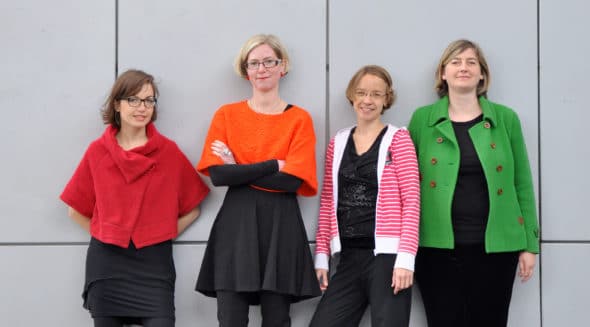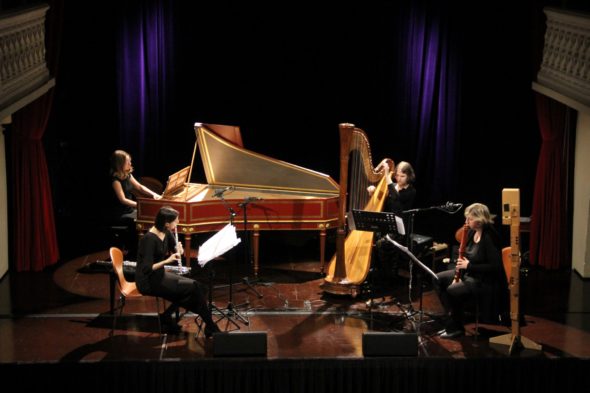
With harpsichord, harp, flute and recorder, the ensemble AIRBORNE EXTENDED offers a unique tonal terrain for contemporary composers. New works by HANNES KERSCHBAUMER, ONUR DÜLGER, ELISABETH SCHIMANA and BRUNO STROBL, for example, were created around the “double duo”. The musicians take care to include at least one piece composed by a women in every concert programme and have considerably expanded the repertoire for this extraordinary ensemble. AIRBORNE EXTENDED is also in demand internationally and in the fortunate position of performing pieces more than once. So what makes the ensemble, consisting of SONJA LEIPOLD, CAROLINE MAYRHOFER, DORIS NICOLETTI and TINA ZERDIN, so appealing? Time to take stock. In the interview Caroline Mayrhofer and Sonja Leipold speak about their curiosity for new repertoire and interest in discovering international composers.
“We take the best pieces from everywhere and include them in our repertoire.”
airborne extended was founded to play an existing repertoire for harp, harpsichord, flute and recorder. The Italian ensemble Alter Ego laid the foundation for this repertoire in 1992. What fascinated you about this lineup?
Caroline Mayrhofer: The initial fascination came from the repertoire inspired by Alter Ego. They’re very good pieces which are quite challenging to perform. Furthermore, there is this special harmony of the instrumentation. Two duos with flute and string instruments create many interesting sound possibilities.
Already as a young ensemble you seemed to be a very well-rehearsed formation, that found a very harmonious form here. Could this be due to you being successful in various formations and as soloists, but together as airborne extended you were able to pursue a certain quality?
Caroline Mayrhofer: Yes, we are all active in the field of new contemporary music with different formations and are interested in new things. And we do like and want to make good chamber music.
Sonja Leipold: I’m sure that affinity for chamber music is something we all have in common. It is always nice to experience how we as an ensemble have grown together in recent years and how we are still growing together. We perform many of “our” compositions more frequently and not just once or twice, as is unfortunately often the case in contemporary music. It is interesting for us to see how these pieces change by playing them more often and how freely, confidently and musically spontaneous it makes us play.
“ […] I notice a process of rethinking as soon as they see and hear the quite extensive repertoire of our ensemble.”
You have been constantly expanding the repertoire for this special ensemble by commissioning compositions for six years now. Would you say that you have made a difference in the last five or six years?
Caroline Mayrhofer: Originally, we weren’t interested in that, but something actually changed. All around, composers have become aware of us, and they are interested in the sound of our ensemble. This has resulted in many very good pieces and a new repertoire. Because of our participation in the NASOM [“New Austrian Sound of Music”; note] programme we were able to present ourselves internationally in many countries. We take the best pieces from everywhere and include them in our repertoire. A project by the IGNM [International Society for New Music] helped us a lot by supporting us in performing the repertoire of composers of the IGNM.
Sonja Leipold: Last but not least, thanks to the project by IGNM, we also held master classes for students of composition classes at many international universities and conservatories. There we often feel a great interest in our instruments and our instrumentation. Fortunately, there is a great deal of response, both from students and teachers. As a harpsichordist, I already have the impression that the expansion of the repertoire has made a big difference. Many of my colleagues, whether they are composers or harpsichordists, who were initially sceptical about the contemporary harpsichord, have changed their minds as soon as they see and hear the quite extensive repertoire of our ensemble.

“our instruments are rather unknown terrain for composers”
One advantage of working with contemporary composers is certainly being able to consult them. Would you describe this process as a dialogue?
Caroline Mayrhofer: Yes, for composers, our instruments, i.e. harpsichord, harp and recorder, are rather unknown terrain. Many composers come to us before writing and let Sonja show them the sounds on the harpsichord.
Sonja Leipold: The first meetings are often about showing the “normal”, original tonal and technical possibilities of the harpsichord. There aren’t many composes who have the opportunity to try out a really good and sonically flexible harpsichord. In recent years a large repertoire of extended playing techniques has developed, which I am happy to pass on. On the other hand, I have learned a lot from various composers and only discovered them through them.
Have you currently commissioned a composition? Is there a commissioned work that you are currently working on?

Caroline Mayrhofer: Many! We have extended our sensors to Germany and to the Ukraine. We have placed orders with Marcus Schmickler, Mikolaj Laskowski, Maxim Kolomieets, Anna Arkushyna, and – in Austria – Elisabeth Harnik. As an ensemble we don’t have a budget for commissions ourselves, but we are grateful for the support of the SKE [Social & Cultural Institutions], the Federal Chancellery and the Ernst von Siemens Stiftung.
Compared to other ensembles, it is outstanding that the amount of commissions awarded to female and male composers is almost equal. Do gender relations and gender play a role?
Caroline Mayrhofer: Yes, we make sure to have at least one female composer included in our concert programme. Because of our cast of four women, we are sometimes invited to women-specific themes, like a matinee in Mumok (Museum of Modern Art) about the feminist avant-garde…
Sonja Leipold: The festival Intrada in Timisoara, Romania invited us on the occasion of its anniversary theme “Women’s Rights – Human Rights”. Our cast of four women came about by chance.
What has been the most technically demanding piece for you so far? Please give us a few insights into the rehearsal process.
Caroline Mayrhofer: “Conduites d’Approche” by Gabriele Manca is a score which is very difficult to read with a lot of notes and complex rhythm. Playing it together is a challenge.
Sonja Leipold: The quartet [London in the Rain, Monadologie XXIX; Note] by Bernhard Lang is also very delicate and transparent. You can hear every tiny deviation. But it is also very rewarding to work on. There are always pieces where individual parts are very close to the impossible. Quite often, we only rehearse very short sections. This precision is then transferred onto the rest of the piece. The fact that we have been playing together for so long makes the rehearsal phases easier and faster.
Tours are planned for airborne extended. In spring you played at the Greek National Opera in Athens, then at festivals in Great Britain, Ukraine, Canada and Italy. Is there a festival that is or has been particularly important to you?
Caroline Mayrhofer: For us it is interesting to find the coolest composers in a certain country and find out whether or not there already is a repertoire we can use.
Sonja Leipold: It’s very rewarding to get to know artists in different countries, to make contacts, and gain insight into their professional environments – and to the diverse musical aesthetics. It is often the small festivals that do very interesting work with a lot of commitment and a small budget.
“Once I have figured out the content, the interpretation is clear […]”
In 2017 you, Caroline Mayrhofer, played a piece at Wien Modern that requires circular breathing. Did you learn this especially for Julien Feltrin´s “high piercing”? How much freedom do performers have in contemporary pieces? How much freedom for interpretation is there in older music?
Caroline Mayrhofer: Actually, I have been able to do circular breathing for many years. I once learned it for “Austro” from Giorgio Tedde – and for “high piercing”. I have had it in my repertoire for a long time. With older music, the challenge is more of finding out what the piece is made of; to investigate a language that we are no longer familiar with. Once I have figured out the content, the interpretation is clear and doesn’t need anything extra.
The harpsichord has been a regular part of contemporary music for the past ten years. Were there any particular pioneers?
Sonja Leipold: The revival of the harpsichord actually began in the 1920s, when Wanda Landowska began working with contemporary composers such as Poulenc, de Falla and others. Elżbieta Chojnacka and Antoinette Vischer were other important European pioneers, in whose circle works by Xenakis, Berio, Haubenstock-Ramati, Brown, Carter, Glass, Sciarrino, Ligeti, Saariaho, Gubaidulina etc. were written. Goska Isphording from Amsterdam has been a very influential contemporary harpsichordist for about 15 years. In Austria it is Maja Mijatovic. Fortunately, more and more composers are using the harpsichord as a solo or ensemble instrument in their works. Today the contemporary harpsichord repertoire has even found its way into concert studies. But there is certainly some more initiative needed to bring composers and harpsichordists together.
Are there any specific playing techniques that can only be applied to the harpsichord?
Sonja Leipold: I am not aware of any completely exclusive playing techniques. A lot of what works on the harp and the piano also works on the harpsichord in a slightly adapted form. And vice versa. The tonal result is more or less different.
“contemporary composers are alive […]”
As we mentioned earlier, you teach master classes every now and then. What do you teach your students with regard to the interpretation of baroque music, and what with regard to contemporary music?
Sonja Leipold: No matter whether it is contemporary or baroque repertoire, I always try to pick up the students where they are and awaken their interest in dealing with a work and a composer on many levels. It is very important to me that they can grow a piece themselves and develop their own personal musical expression. With regard to contemporary music, I particularly encourage my students to have direct contact with the composers. I tell them: “Be glad that contemporary composers are alive and that you can ask them directly. Discuss with them, work together on their pieces to find your very personal interpretation”.
Thank you very much for the interview!
Ruth Ranacher – translated from the German interview by Dave Dempsey
Links:
airborne extended
